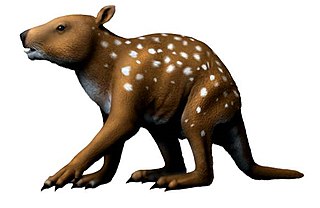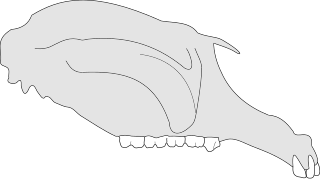
The order Peramelemorphia includes the bandicoots and bilbies. All members of the order are endemic to Australia-New Guinea and most have the characteristic bandicoot shape: a plump, arch-backed body with a long, delicately tapering snout, very large upright ears, relatively long, thin legs, and a thin tail. Their size varies from about 140 grams up to 4 kilograms, but most species are about one kilogram.

Bandicoots are a group of more than 20 species of small to medium-sized, terrestrial, largely nocturnal marsupial omnivores in the order Peramelemorphia. They are endemic to the Australia–New Guinea region, including the Bismarck Archipelago to the east and Seram and Halmahera to the west.

Thylacinidae is an extinct family of carnivorous marsupials from the order Dasyuromorphia. The only species to survive into modern times was the thylacine, which became extinct in 1936.

Phascolarctos is a genus of marsupials with one extant species, the koala Phascolarctos cinereus, an iconic animal of Australia. Several extinct species of the genus are known from fossil material, these were also large tree dwellers that browsed on Eucalyptus leaves.

Thylacoleo is an extinct genus of carnivorous marsupials that lived in Australia from the late Pliocene to the Late Pleistocene, often known as marsupial lions. They were the largest and last members of the family Thylacoleonidae, occupying the position of apex predator within Australian ecosystems. The largest and last species, Thylacoleo carnifex approached the weight of a lioness. The estimated average weight for the species ranges from 101 to 130 kg.

Yalkaparidon is an extinct genus of Australian marsupials, first described in 1988 and known only from the Oligo-Miocene deposits of Riversleigh, northwestern Queensland, Australia.

Wakaleo is an extinct genus of medium-sized thylacoleonids that lived in Australia in the Late Oligocene and Miocene Epochs. Although much smaller than its close relative, the marsupial lion, Wakaleo would have been a successful hunter. It had teeth specially designed for cutting and stabbing. The genus is from an extinct family of Vombatiformes, so it is distantly related to the herbivorous wombats.

Ekaltadeta is an extinct genus of marsupials related to the modern musky rat-kangaroos. Ekaltadeta was present in what is today the Riversleigh formations in Northern Queensland from the Late Oligocene to the Miocene.

Bettongs, species of the genus Bettongia, are potoroine marsupials once common in Australia. They are important ecosystem engineers displaced during the colonisation of the continent, and are vulnerable to threatening factors such as altered fire regimes, land clearing, pastoralism and introduced predatory species such as the fox and cat.

The Riversleigh rainforest koala is an extinct marsupial, closely related to the extant koala, that inhabited northwestern Queensland in the early-middle Miocene. It is the only species assigned to the genus Nimiokoala. Along with species of sister genus Litokoala, the Riversleigh rainforest koala is the smallest representative of family Phascolarctidae. Based on cladistic analysis, Nimiokoala is one of the more basal genera of Phascolarctide. It died out due to climate change rendering the environment more arid. It probably had a more generalized diet than that of the modern species, but its exact food preferences are unknown.

Neohelos is an extinct diprotodontid marsupial, that lived from the early to middle-Miocene. There are four species assigned to this genus, Neohelos tirarensis, the type species, N. stirtoni, N. solus and N. davidridei. N. davidridei is the most derived species of the genus, and its premolar morphology shows that it is structurally and ancestor of the genus Kolopsis. All four species are from the Bullock Creek in the Northern Territory and Riversleigh of Australia.
Warendja is an extinct genus of wombat. It is known from two species, W. encorensis from the Late Miocene Riversleigh site in Queensland, and W. wakefieldi known from the Pleistocene of South Australia, New South Wales, and Victoria. The two species are primarily distinguished by features of their enamel. It became extinct as part of the Quaternary extinction event. Warendja wakefieldi is estimated to have weighed about 10 kg, considerably smaller than living wombats. Warendja thought to be relatively basal amongst wombats, being the most primitive member to possess hypselodont cheek teeth. The morphology of the humerus of W. wakefieldi suggests that it engaged in scratch-digging.

Propleopus is an extinct genus of marsupials. Three species are known: P. chillagoensis from the Plio-Pleistocene, and P. oscillans and P. wellingtonensis from the Pleistocene. In contrast to most other kangaroos, and similar to their small extant relative, the musky rat-kangaroo, they were probably omnivorous.
Ganguroo is a genus of fossil macropods found at Riversleigh in Australia, material dating from the Middle to Late Miocene Epoch. The type species of the genus is Ganguroo bilamina, published in 1997. Two recently described species, Ganguroo bites and Ganguroo robustiter, have also been placed in this genus.
Malleodectes is an extinct genus of unusual marsupial, first discovered in 2011 at Riversleigh, Queensland, Australia.
Cookeroo is a genus of extinct kangaroos from the Late Oligocene and Early Miocene found in fossil deposits from the Riversleigh World Heritage Area, in Australia. The genus includes two species, C. bulwidarri and C. hortusensis.
Riversleigh fauna is the collective term for any species of animal identified in fossil sites located in the Riversleigh World Heritage Area.

Propalorchestes is a fossil genus of palorchestid marsupial that existed in Australia during the Miocene epoch.
Lekaneleo roskellyae is a fossil species of carnivorous marsupial that existed during the early Miocene in Australia. Once allied to the type species of the genus Priscileo, later placed as Wakaleo pitikantensis, "Priscileo" roskellyae was subsequently transferred to its own genus Lekaneleo.
Whollydooleya tomnpatrichorum is a fossil species discovered just beyond the Riversleigh World Heritage Area, an early example of adaptations to hypercarnivory. The dating of the deposit, while uncertain, is associated with material assigned to the genus Ekaltadeta, placing its occurrence in the middle or late Miocene epoch.


















